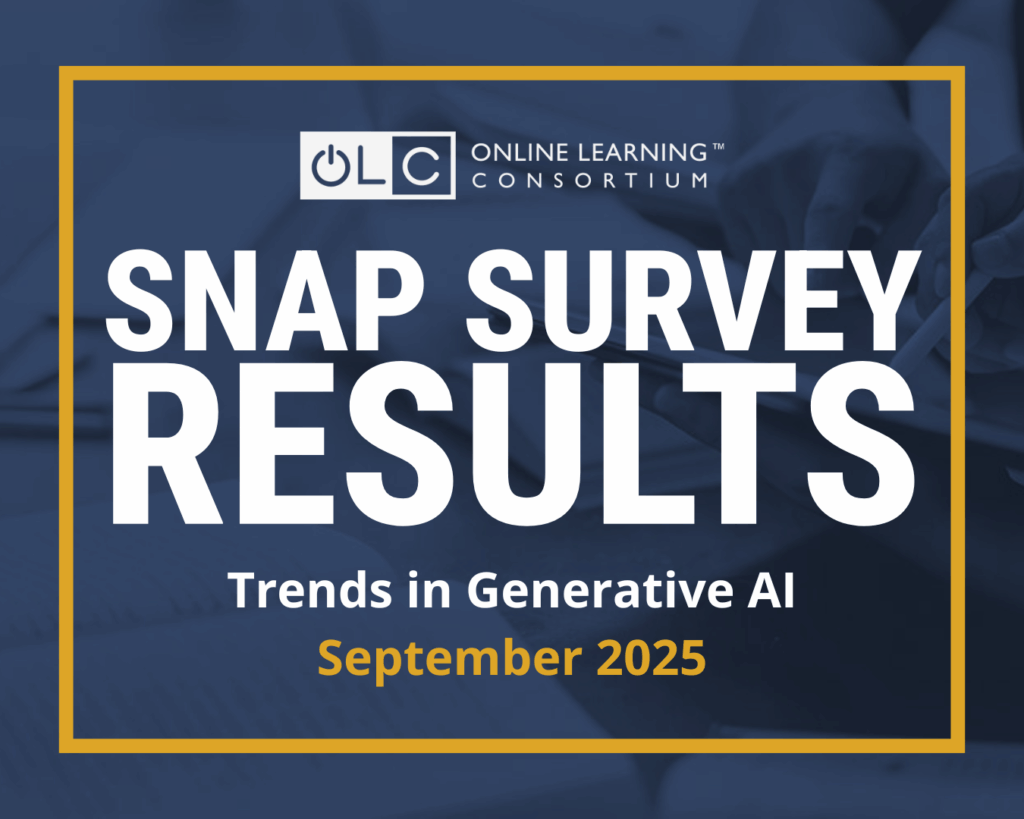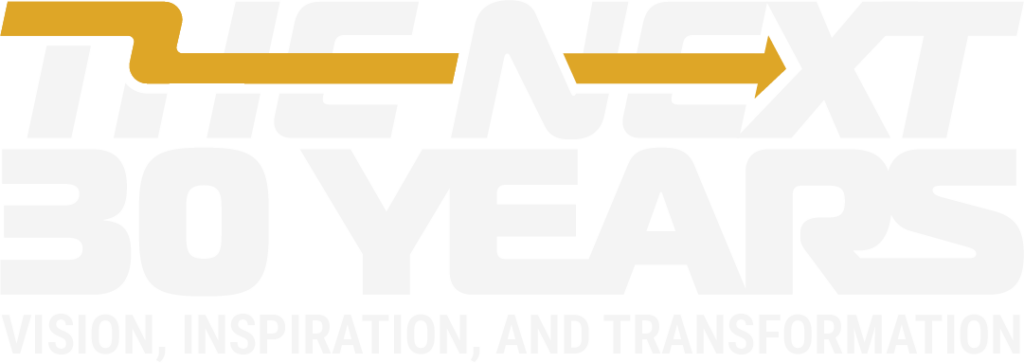Artificial intelligence is no longer hovering at the edges of education—it has entered classrooms, labs, and workplaces. I was fortunate enough to be invited to moderate a discussion of AI and education at the International Conference on Economics, Business & Management (ICEBM 2025). The panel on AI & Education consisted of a diverse group of educators and technologists who reflected on how generative AI (GenAI) is reshaping teaching, learning, and faculty work. The conversation was lively, personal, and at times cautionary, highlighting both practical strategies and deeper philosophical questions. Through my work as Senior Researcher at OLC and Managing Editor of the Online Learning journal, I regularly engage with research exploring Generative AI in education—both my own and others’. One of the things I appreciated most about being able to moderate this panel was the opportunity to hear from others who are on the cutting edge of GenAI integration in teaching and learning.
Panelists included Ryan Anderson (University of Wisconsin System), Quincy Conley (A.T. Still University), Karen LaPlant (Minnesota State Colleges and Universities system), Sheri Hutchinson (Minnesota State Colleges and Universities system), and Balazs Koren (Hungarian Education Technology Alliance). The session was moderated by me and hosted by Plamen Miltenoff (University of Economics Varna), who managed tech hiccups with good humor and encouraged audience participation throughout. Below you will find the main topics discussed and some of the important points brought up by our panelists.
From the Internet to AI: Lessons in Adoption
Ryan opened with a comparison: just as email and the internet once disrupted higher education, generative AI is now demanding new literacies. His point was simple but powerful—students must be taught not to accept AI at face value, but to critically interrogate it.
Sheri agreed, suggesting concrete classroom practices. In group projects, students could assign AI new roles such as Prompter, Fact Checker, or Humanizer. This reframes AI as a teammate rather than a forbidden tool, while also teaching students to manage its contributions responsibly. In class discussions, AI-generated counterarguments can deepen debate, while in presentations, students can compare AI-created visuals against human work to refine both.
Karen emphasized that this shift requires more than new assignments. It calls for AI literacy—a mindset where students are trained to ask “why” and “how” rather than just “what.” For her, skills like prompt engineering and collaborative use of AI are not optional add-ons but essential preparation for AI-augmented workplaces.
AI in Action: Health Sciences and Beyond
One of the most compelling moments came from Quincy, who shared an example from health sciences. First-year physical therapy students at his institution used an AI tool to practice SOAP note-taking and patient interview skills. The results were so promising that the project not only improved learning but also led to a published journal article. For Quincy, this illustrated AI’s capacity to support authentic, skills-based learning that aligns with professional standards.
Balazs added an international perspective, comparing the present moment to the early days of the internet. He encouraged experimentation but warned against overhyping AI. In his view, educators must strike a balance—exploring AI’s possibilities while staying grounded in pedagogy and ethics.
Lightening the Faculty Load
The panel also explored how AI is already reducing faculty workload. Ryan described how Wisconsin is piloting AI to draft discussion questions, analyze student interactions, and generate rubrics—freeing faculty to invest more time in student support. “This doesn’t mean outsourcing teaching,” he stressed, “but clearing space for human connection.”
Sheri reinforced this point, showing how AI can draft lesson plans, summarize discussions, and even prepare multilingual communications for diverse learners. Karen noted her own experience using AI to generate differentiated materials for students at varying levels, or to draft professional communications that teachers can then personalize.
Quincy pointed out that AI can also standardize evaluation, particularly in clinical education. For him, this represents a way to ensure objectivity and consistency in assessing large cohorts of students.
All agreed, however, that AI’s role should remain supportive. Faculty must guide and refine its outputs, ensuring that technology never eclipses human oversight.
Feedback, Risks, and the Human in the Loop
Generative AI’s potential for formative feedback drew both excitement and caution. Sheri described how AI can quickly respond to open-ended writing with suggestions on clarity and structure. Yet she also warned of risks: inaccuracies, bias, overreliance, and privacy concerns.
Ryan illustrated the benefits of immediacy. A student writing a lab report, for example, could receive instant AI feedback on whether their argument is clear. A history student could get notes on whether evidence supports a thesis. This immediacy, he said, keeps students engaged—but it must be coupled with reflection. Faculty are encouraged to have students explain what feedback they accept, what they reject, and why.
Karen described this as “closing the loop.” AI can accelerate feedback cycles, but educators must remain “in the loop” to ensure guidance remains nuanced and empathetic. Quincy echoed this, positioning teachers as mentors who help students contextualize AI feedback rather than simply consume it.
Deep Research and Critical Comparison
The panel also touched on “deep research”—the practice of using AI models to analyze, connect, and reason across multiple documents. . By completing deep research with multiple AI models, students can see where answers align, where they diverge, and why. Ryan argued that this transforms research from finding the single “right” answer into a process of triangulation and critical comparison.
Quincy saw this as a step toward proactive teaching design, preparing students for workplaces where diverse perspectives matter. Sheri shared her own professional use of deep research in legislative and grant analysis, where prompting AI to “think carefully” has surfaced overlooked insights. Karen urged educators to expose students to multiple platforms to prevent overreliance on a single tool.
Responsibility and Reflection
Responsibility was a recurring theme. Sheri recounted an example where AI-generated content falsely reported a presenter’s father as deceased—only for the father to walk onstage alive. The lesson: AI outputs must always be interrogated. She recommended frameworks like SIFT (Stop, Investigate, Find, Trace) to help students verify information before accepting or sharing it.
Quincy suggested strategies like peer debates and cross-checking AI with scholarly sources. Ryan argued that classrooms should treat AI not just as a tool but as an object of evaluation. Karen framed this as part of digital citizenship, urging students to remain skeptical and active in their verification.
Balazs was the most forceful in his caution. He warned against allowing education to bend toward pleasing AI algorithms, arguing that this risks stifling creativity and dehumanizing knowledge. For him, human expertise and context must remain central.
Audience Engagement and Action Steps
Towards the end of the discussion, I invited questions from the audience, which sparked a lively exchange. One participant raised concerns about whether education might drift toward algorithmic compliance. Others asked about AI tutoring. This led to a practical outcome: Quincy was connected with an instructor who had developed a tutoring system using a Gemini agent. Ryan agreed to share his materials on GPT-powered administrative tools, and Balazs agreed to continue discussions on K–12 applications.
These follow-up commitments underscored that the panel was not just a theoretical discussion but a springboard for collaboration.
Looking Ahead
The panel closed with a shared recognition: AI is here to stay, and it will transform education in ways we are only beginning to grasp. It can democratize expertise, streamline workload, provide real-time feedback, and prepare students for AI-augmented workplaces. Yet it also carries risks—bias, overreliance, misinformation, and the temptation to hand over too much intellectual labor to machines.
As host Plamen Miltenoff summarized, the future of AI in education will depend not on seeing it as an all-knowing oracle but as a partner that challenges us to think harder, teach more creatively, and remain deeply human in our approach to learning.
For more information about our panelists, please read their bios:

Ryan Anderson is a member of the senior leadership team within the Universities of Wisconsin Office of Online & Professional Learning Resources (OPLR). In this capacity, he guides the organization’s mission to deliver exceptional service and support across all 13 Universities of Wisconsin and the Universities of Wisconsin Administration in online and continuing education, teaching and learning, and workforce training.
Before joining OPLR, Anderson honed his expertise at Epic, the nation’s leading healthcare software company, where he served as the divisional leader for e-learning and training. His career also includes time as an adult education instructor at Madison College and as a K-12 educator, experiences that have deepened his understanding of diverse learning needs and environments. A sought-after speaker at regional and national conferences, Anderson thrives on building high-performing teams, empowering individuals to leverage their unique talents for collective success.
A recognized innovator in online education, Anderson has seamlessly blended technology with instructional design to transform the virtual learning experience. In 2016, he received UW-Madison’s Shauna Schullo Best Distance Teaching Practices Award. Under his leadership, his team collaborates with faculty on a rigorous design process informed by the latest instructional theories. They employ cutting-edge practices such as competency-based education, virtual reality, gamification, adaptive learning, scenario-based learning, microcredentialing, and Generative AI.

Dr. Quincy Conley is the Director of the Teaching & Learning Center at A.T. Still University, where he leads initiatives to help faculty integrate innovative teaching strategies and educational technologies into health sciences education. With more than 20 years of experience in instructional design and learning science, Dr. Conley focuses on bridging theory, practice, and technology to address the pressing challenges facing educators today.
His research explores the role of artificial intelligence and emerging technologies in shaping learning, with projects that leverage biometric data, augmented reality, and intelligent tutoring systems to evaluate and improve the effectiveness of online and in-person learning experiences. He is particularly interested in how AI can enhance teaching, support faculty development, and improve student engagement in professional education.
Dr. Conley earned his PhD in Educational Technology from Arizona State University and both his MA in Instructional Design & Technology and BA in Aerospace Science from the University of North Dakota.
Areas of expertise: AI in education, course and program design, biometric research methods, learning innovation.

Sheri Hutchinson, Ph.D. is a higher education leader, consultant, and grant strategist with more than 20 years of experience in academic operations, workforce development, and student success. She currently serves with the Minnesota State System Office, supporting Perkins V initiatives across 23 consortia, and is the founder of Grants – Wings of Change, where she helps nonprofits and education organizations leverage funding, AI, and innovative strategies to expand capacity and impact. Dr. Hutchinson specializes in integrating artificial intelligence into education and grant writing practices, with a focus on equity, access, and practical outcomes.

Balázs Koren is a Hungarian mathematics educator and EdTech innovator dedicated to weaving artificial intelligence into everyday teaching practice. Drawing on years of classroom experience in secondary schools and at the university level, he brings deep pedagogical insight to technology integration.
He is professional lead of Yettel Hungary’s digital education program (active for over a decade), professional lead of the EdTech Coalition, and Digital Education Advisor at EduTech Hungary.
A frequent speaker at Hungarian and international conferences, Balázs showcases hands-on examples of AI-powered pedagogy that inspire teachers to experiment and students to explore. He shares practical strategies and critical reflections on AI’s impact on education, digital equity, and classroom practice on his blog and YouTube channel.
 As senior researcher at OLC, Carrie designs, conducts and manages the portfolio of research projects that align with the mission, vision, and goals of the Online Learning Consortium. She brings with her over 15 years of experience as an online educator and instructional designer with a passion for research. She has peer-reviewed publications covering a variety of topics such as open educational resources, online course best practices, and game-based learning. In addition to a strong background in higher education teaching and instructional design, Carrie brings with her extensive experience in customer service and small business management. She holds a PhD in Educational Technology from Arizona State University, an MS in French from Minnesota State University, and BA in French from Arizona State University.
As senior researcher at OLC, Carrie designs, conducts and manages the portfolio of research projects that align with the mission, vision, and goals of the Online Learning Consortium. She brings with her over 15 years of experience as an online educator and instructional designer with a passion for research. She has peer-reviewed publications covering a variety of topics such as open educational resources, online course best practices, and game-based learning. In addition to a strong background in higher education teaching and instructional design, Carrie brings with her extensive experience in customer service and small business management. She holds a PhD in Educational Technology from Arizona State University, an MS in French from Minnesota State University, and BA in French from Arizona State University.






